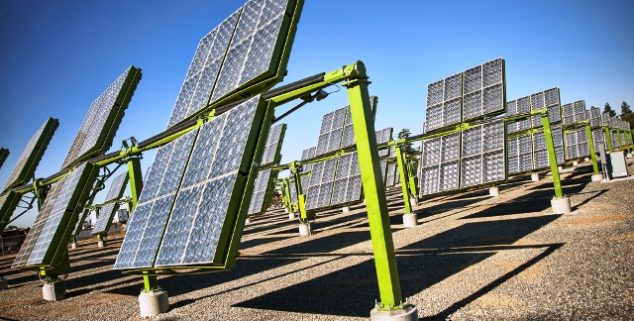Opinion
Location, location: Solar PV and the San Joaquin Valley
 Solar PV panels used to power agricultural equipment in the Central Valley. (Photo: Shippee, via Shutterstock)
Solar PV panels used to power agricultural equipment in the Central Valley. (Photo: Shippee, via Shutterstock)California’s push to achieve 50 percent of our electricity from renewable sources by 2030 will entail a significant deployment of large-scale solar photovoltaic (PV) installations. With the falling price of solar PV, that technology may make up almost all of the renewable energy deployed in the next decade in California.
Eight in ten Californians say we ought to build more solar power facilities. But when it comes to locating specific projects, the public’s yearning for more clean energy with less pollution often clashes with other resource priorities — like land and species conservation.
Out of the 9.5 million acres in the stakeholder study area, the groups identified 470,000 acres of ideal, non-controversial land for solar PV development,
That some people call these facilities “solar farms” is itself an irony. In places like the San Joaquin Valley, proposed installations have engendered conflicts with agricultural preservation groups, who fear a resulting loss of valuable farmland. Meanwhile, conservation groups have sued over the potential loss of critical habitats for endangered species and other environmental values. Litigation, costly and delayed permitting, loss of lands with agricultural and biological importance, and many missed opportunities have therefore dogged the process.
To address the challenge, Berkeley Law’s Center for Law, Energy and the Environment (CLEE) partnered with Conservation Biology Institute (CBI) and Terrell Watt Associates to develop a new process to find “least-conflict” lands in the eight-county San Joaquin Valley region. We convened leaders from the agricultural, conservation, and solar PV development communities, and included tribes and key agencies. We asked the groups one question: from your perspective, where are the least-conflict lands for solar PV development in the Valley?
The groups then worked with CBI’s cutting-edge but straightforward on-line mapping platform, called Data Basin Gateway (sjvp.databasin.org). Individual stakeholder working groups were formed and provided scientific and technical support. Each group identified important data sets and assembled them to attempt to identify lands with high-value for solar development potential but least conflict for agriculture and conservation values.
Based on the results, policy makers ought to encourage solar expansion on these optimal lands and streamline the planning processes
When we combined the separate maps, the result was pretty remarkable: Out of the 9.5 million acres in the stakeholder study area, the groups identified 470,000 acres of ideal, non-controversial land for solar PV development, or roughly 5 percent of the Valley study area. At a generic calculation of 1 megawatt of solar PV production from 5 acres of panels, that means the lands identified could provide 94,000 megawatts of renewable power – greater than all combined in-state generation capacity and enough to power as many as 23 million homes in California with low-cost, clean electricity. And that’s just from the San Joaquin Valley.
To be sure, not all of this land, on further inspection, may be practical or feasible for solar PV development. But if even a fraction works, it will accelerate the state’s renewable efforts and reduce the impact of air pollution on Valley communities.
Even more exciting, this stakeholder-led process was completed in just six months, while the web-based map remains on-line to be updated and improved over time.
Based on the results, policy makers ought to encourage solar expansion on these optimal lands and streamline the planning processes to steer more solar PV development there. They should consider siting and fast-tracking appropriate transmission capacity to these lands, as well as develop other permitting incentives, leading to better results at less cost and time. We also encourage policy makers to support similar mapping processes throughout the state.
Our results could certainly benefit the San Joaquin Valley, helping local leaders balance agricultural production with renewable deployment to maximize the economic gains of state energy policy. But now that we’ve tested it in the Valley, we have a model that can be employed throughout the state and country to hopefully minimize land-use conflicts going forward. Given the urgency of climate change and the scale of the need for clean technology deployment, it can’t happen soon enough.
—
Ed’s Note: Ethan N. Elkind directs the Climate Change and Business Program at UC Berkeley’s School of Law. Jim Strittholt is the executive director of the Conservation Biology Institute. They co-authored the new report “A Path Forward: Identifying Least-Conflict Solar PV Development in California’s San Joaquin Valley.”
Want to see more stories like this? Sign up for The Roundup, the free daily newsletter about California politics from the editors of Capitol Weekly. Stay up to date on the news you need to know.
Sign up below, then look for a confirmation email in your inbox.

Leave a Reply